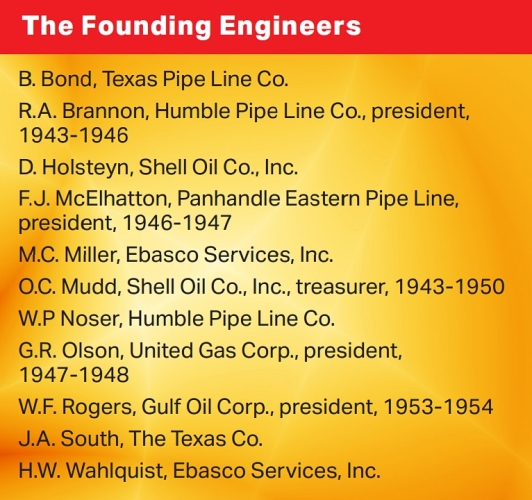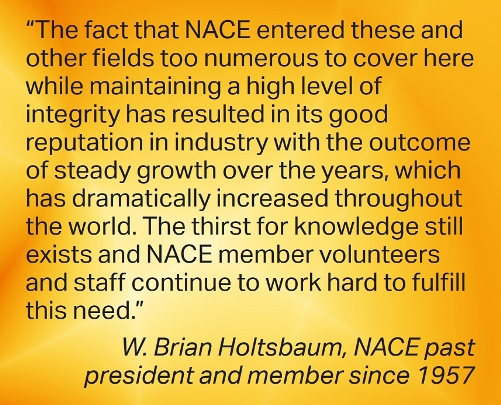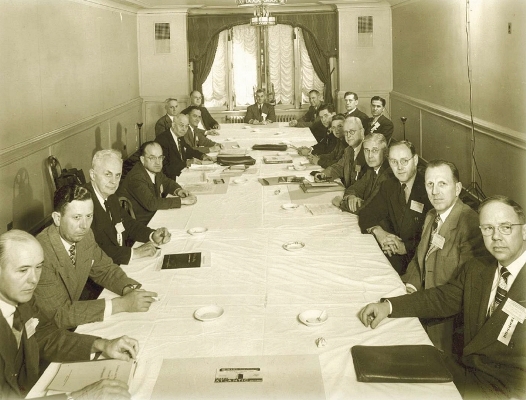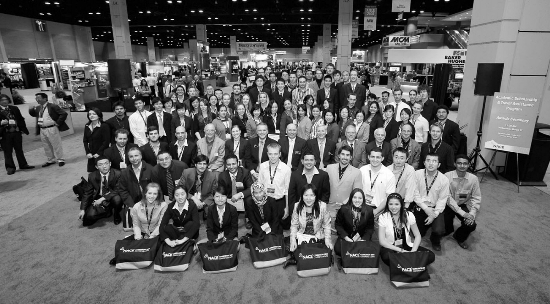As the corrosion control industry has developed and grown, NACE International established itself early on as an organization committed to controlling and preventing corrosion. From its beginnings as a small group of engineers focused on cathodic protection (CP) to address metal pipeline degradation, NACE has evolved into a worldwide organization that is involved in every industry and area of corrosion prevention and control, from oil and gas and water systems to marine, transportation, and infrastructure protection.
Next year the association celebrates its Diamond Anniversary, a milestone made possible by the knowledge, expertise, and continued support of its members from around the globe. As it has in the past, NACE continues to advance education and training, technical discussions, and standards development and advocate corrosion control as part of its mission to equip society to protect people, assets, and the environment from the adverse effects of corrosion.
NACE Founded in 1943
 At the beginning of the 20th Century, little was known about the science of corrosion control. By the 1930s, however, significant strides in corrosion mitigation had been achieved and CP had come into widespread use to control corrosion on underground pipelines. This generated well-founded concern about possible damage to adjacent structures from stray current. It soon became apparent that a dedicated organization was needed to serve as a clearinghouse for information about underground operations and to establish standard procedures for installing and maintaining CP systems. This led to the formation of the Houston, Texas-based Mid-Continent Cathodic Protection Association in 1938. In 1940, the Petroleum Industry Electrical Association (PIEA) offered to sponsor the work of this group, which then became the PIEA Cathodic Section. Members of this section quickly determined the value of forming a separate association dedicated specifically to corrosion and its control. On October 9, 1943, 11 corrosion engineers agreed to found this endeavor, and the National Association of Corrosion Engineers (N.A.C.E.) was born.
At the beginning of the 20th Century, little was known about the science of corrosion control. By the 1930s, however, significant strides in corrosion mitigation had been achieved and CP had come into widespread use to control corrosion on underground pipelines. This generated well-founded concern about possible damage to adjacent structures from stray current. It soon became apparent that a dedicated organization was needed to serve as a clearinghouse for information about underground operations and to establish standard procedures for installing and maintaining CP systems. This led to the formation of the Houston, Texas-based Mid-Continent Cathodic Protection Association in 1938. In 1940, the Petroleum Industry Electrical Association (PIEA) offered to sponsor the work of this group, which then became the PIEA Cathodic Section. Members of this section quickly determined the value of forming a separate association dedicated specifically to corrosion and its control. On October 9, 1943, 11 corrosion engineers agreed to found this endeavor, and the National Association of Corrosion Engineers (N.A.C.E.) was born.
Association Growth over the Decades
The first officers to lead the fledgling organization were President R.A. Brannon, Vice President F.J. McElhatton, Secretary-Treasurer O.C. Mudd, and Directors G. Gorfield, G.R. Olson, R. Pope, W.F. Rogers, and L.R. Shephard. In 1945, with 268 members, NACE was officially incorporated under Texas law as a not-for-profit technical association. In 1946, the Houston Section was the first section formed and association membership grew to 801. The South Central and Western Regions were established in 1946, followed by the Southeast and North Central Regions in 1947. By the end of the 1940s, NACE had five regions, 17 sections, and more than 1,700 members.

NACE also began broadening its scope during its formative years, expanding beyond a purely CP and pipeline focus to include the oil and gas production, chemical processing, and refining industries, as well as other methods of corrosion control such as protective coatings and linings, chemical treatment, and materials selection and design. This, along with increasing public knowledge and concern about the costly and damaging effects of corrosion, served to fuel impressive membership growth throughout subsequent years. Today, the association (renamed NACE International in 1993) has four areas and 80 sections in North America, four international areas with 61 sections, and a total of more than 36,000 members from 140 countries. In addition to NACE headquarters in Houston, Texas, there are now staff offices in Al-Khobar, Saudi Arabia; Kuala Lumpur, Malaysia; San Diego, California; Sao Paulo, Brazil; and Shanghai, China.
Technical Committees
The need to develop corrosion control technologies and document them for use in industry was the primary force driving NACE’s formation. Two technical committees were established in 1944 to make headway in the areas of condensate well corrosion and galvanic anode testing. These committees soon merged into the newly established NACE Technical Practices Committee (TPC) under the leadership of R.B. Mears.
The TPC grew rapidly—by 1949 it comprised 13 subcommittees encompassing all methods of corrosion control and prevention. The number grew to 19 subcommittees before a reorganization in 1954 combined them into several group committees. The evolution of the TPC is documented in L. Perrigo’s book, A History of the NACE Technical Practices Committee and Technical Committees, which was released in 1993 to coincide with NACE’s 50th Anniversary.
The TPC generated numerous technical reports in the 1950s and early 1960s. In 1966, the Board of Directors approved the association’s next step toward becoming a standards-writing organization to document emerging corrosion control technologies and how they should be used. By 1969, NACE completed and issued two standards: TM0169, “Laboratory Corrosion Testing of Metals for the Process Industries,” and RP0169, “Control of External Corrosion on Underground or Submerged Metallic Piping Systems.” In 1970, the TPC held its first Technical Committee Week (later renamed Fall Committee Week) in Dallas, Texas, which attracted 260 members in 50 technical groups that held 146 meetings, two TPC training sessions, as well as other gatherings and events.
 The TPC underwent a significant reorganization in 2000 that was designed to speed up standards development, reduce the number of administrative meetings, simplify information exchange, and make it easier to develop joint standards across NACE subcommittees and other associations. The TPC was renamed the Technical Coordination Committee (TCC), and technical committees were organized by Specific Technology Groups (STGs), Task Groups (TGs), and Technology Exchange Groups (TEGs). Today there are more than 345 technical committees comprised of 3,400 members.
The TPC underwent a significant reorganization in 2000 that was designed to speed up standards development, reduce the number of administrative meetings, simplify information exchange, and make it easier to develop joint standards across NACE subcommittees and other associations. The TPC was renamed the Technical Coordination Committee (TCC), and technical committees were organized by Specific Technology Groups (STGs), Task Groups (TGs), and Technology Exchange Groups (TEGs). Today there are more than 345 technical committees comprised of 3,400 members.
Fall Committee Week became Corrosion Technology Week (CTW) in 2003 to include activities other than technical committee meetings and attract attendees who might not be members. Most technical committees also meet each spring at CORROSION, NACE’s annual conference.
Since NACE issued its first two standards more than five decades ago, the association has developed more than 200 standards and technical reports, including standard practices, materials requirements, and test methods. Recommended practices were changed to standard practices in 2006, and existing recommended practices are being changed to standard practices as they are revised or reaffirmed.
By 2016, the globalization of NACE was embraced by translating more than 50 standards into Chinese and/or Spanish, launching the Section Technology Advisory Group (STAG) program to obtain more participation internationally, and establishing more effective strategies for engaging with the worldwide ISO standards organization.
Annual Conference
NACE’s first annual meeting was held in 1944 at the Rice Hotel in Houston, Texas. There were 260 attendees and the proceedings included 25 papers. As with membership, conference attendance swelled steadily in ensuing years, reaching 2,000 participants in the mid-1950s, 3,000 in the mid-1970s, and 6,000 in the late 1990s and beyond. The annual exhibition has grown from 250 exhibitors in 1994 to 438 exhibitors in 2017, including 87 new exhibiting companies. This annual conference featured 44 technical symposia with 488 paper presentations, six research symposia with 89 presentations, and 196 technical committee meetings. CORROSION 2018 will be held April 15 to 19 in Phoenix, Arizona, featuring special events celebrating NACE’s 75th anniversary.

Recipients of NACE’s prestigious Association Awards have been honored at annual conferences since 1947, when the first two awards presented were named for and given to W.R. Whitney and F.N. Speller. Additional awards were established in 1953 (A.B. Campbell Award), 1973 (R.A. Brannon Award), 1987 (T.J. Hull Award), and 1996 (H.H. Uhlig Award). The Distinguished Service Award (established in 1969) and Technical Achievement Award (initiated in 1986) honor outstanding contributions to the association and the field of corrosion control. On the occasion of its 50th Anniversary in 1993, NACE created two new categories of awards: NACE Fellow and Distinguished Organization Award. The CORROSION journal Best Paper Award was added in 2010.
In addition to the CORROSION conference, NACE conducts a multitude of topical and regional conferences, seminars, and other events around the world.
Publications
 In March 1945, CORROSION debuted as NACE’s official publication to provide a permanent record of the papers prepared for the association at meetings and annual conferences, and from other editorial sources. The journal contained several technical articles, editorials, abstracts from other corrosion papers, information about association activities, and a roster of NACE members. Its frequency grew from quarterly to monthly in 1946, and changed from a 6 by 9-in publication to its current standard magazine format in 1949. In addition to its printed format, CORROSION became available via the Internet in 1998, with subsequent improvements and upgrades for robust access to the journal and other resources at www.corrosionjournal.org.
In March 1945, CORROSION debuted as NACE’s official publication to provide a permanent record of the papers prepared for the association at meetings and annual conferences, and from other editorial sources. The journal contained several technical articles, editorials, abstracts from other corrosion papers, information about association activities, and a roster of NACE members. Its frequency grew from quarterly to monthly in 1946, and changed from a 6 by 9-in publication to its current standard magazine format in 1949. In addition to its printed format, CORROSION became available via the Internet in 1998, with subsequent improvements and upgrades for robust access to the journal and other resources at www.corrosionjournal.org.
The early 1960s saw a departure of the Corrosion Abstracts department in CORROSION. These were published in a quarterly journal entitled Corrosion Abstracts (COR*AB). COR*AB was eventually sold to Cambridge Scientific and can be accessed online by subscription.
In 1961, the NACE Board of Directors approved a recommendation by the Publications Committee to separate “theoretical” and “practical” papers, and in 1962, NACE became a two-journal society. Materials Protection became the official NACE membership publication and CORROSION primarily became a scientific journal. Ivy Parker, who served as editor of Materials Protection, stated in a February 1962 editorial, “Today’s communications problems demand more strenuous efforts and different solutions than those which were satisfactory as recently as five years ago. This magazine is one effort NACE is making to obtain more attention to useful data.”
Materials Protection became Materials Protection and Performance in 1970 as an interim step toward the ultimate plan of changing the magazine’s title to Materials Performance (MP), which occurred in 1974. Then-editor H. Godard wrote, “I am all for the shorter name, but it’s what’s inside that really counts…papers in MP will continue to be practical and will be selected to be useful.” In 1999, MP underwent a redesign and editorial overhaul in response to reader needs for an even wider selection of shorter articles emphasizing practical, hands-on experiences that can help them in their jobs. Today, MP is available in digital format online as well as in print, and is distributed to NACE members and other subscribers each month. The MP web site, www.materialsperformance.com, was launched in 2015 and contains exclusive web articles and news in addition to the magazine content.
In 2006, NACE initiated the phased, three-year acquisition of Four Point Publishing, LLC, which published CoatingsPro Magazine and SprayFoam (NACE later ceased publishing SprayFoam). With a current circulation of more than 26,000 readers—primarily coatings contractors but also specifiers and engineers—CoatingsPro offers an in-depth look at coatings based on case studies, departments featuring topics such as safety, and product and event news. In 2017, CoatingsPro is celebrating its 15th anniversary. As with MP, CoatingsPro has its own web site, www.coatingspromag.com, that features the digital edition of the magazine as well as articles and news unique to the site.
NACE continues to add to its suite of print and online topical and area newsletters, as well those supporting students of NACE education and training.
Education and Training
 The critical need for education and training programs to benefit anyone involved in corrosion prevention and control was recognized early on by NACE leaders. One of the first educational efforts sponsored by NACE was a 1949 short course at the University of Texas at Austin, which was designed for people who dealt with corrosion problems in industry but did not have the background or experience to do so efficiently. NACE developed its first formal education course in the late 1960s—Basic Corrosion—which was initially offered as a correspondence course. The material was then formatted as a four-day course and first offered by the Houston Section in 1971.
The critical need for education and training programs to benefit anyone involved in corrosion prevention and control was recognized early on by NACE leaders. One of the first educational efforts sponsored by NACE was a 1949 short course at the University of Texas at Austin, which was designed for people who dealt with corrosion problems in industry but did not have the background or experience to do so efficiently. NACE developed its first formal education course in the late 1960s—Basic Corrosion—which was initially offered as a correspondence course. The material was then formatted as a four-day course and first offered by the Houston Section in 1971.
Throughout the years, NACE developed many more programs and courses focusing on such areas as CP, protective coatings and linings, materials selection and design, refining, and corrosion fundamentals. Several are now available online and in other languages. The world-renowned Coating Inspector Program (CIP) was developed in the 1980s in response to a request from Group Committee T-6 on Protective Coatings for a certification program to upgrade the coatings industry. By 1985, NACE changed the terminology in its older accreditation programs to certification and began adding certification in specialty fields. All categories have requirements for work experience in the field of corrosion and passing examinations as well as signing a NACE attestation concerning professionalism.
Multiple courses are taught every week throughout the world in NACE facilities—primarily the Elcometer Building in Houston that accommodates more than 3,000 students per year—and company in-house locations. In 2014, NACE opened a 4,000 ft2 (372 m2) training center in Dubai, U.A.E. offering the entire suite of NACE courses. Hundreds of students from the area and surrounding countries are taking advantage of the local center.
In 2012, NACE established the NACE International Institute (NII) to establish an organization focused on certification activities and to further advance the corrosion profession. The institute supports growth and quality of certification for the corrosion control field, improving the business conditions of the industry, and advancing knowledge through certification programs that promote public safety, protect the environment, and reduce the economic impact of corrosion. The NII also leads its certification programs toward compliance with the ISO standard for certification bodies (ISO 17024). Today, it administers 23 certifications plus the CIP endorsements. There are more than 35,000 NACE certification holders worldwide.
Public Affairs
Over the years, NACE Public Affairs has been at the heart of efforts to promote the association, educate society about the importance of corrosion control, and incorporate NACE standards into government regulations. The U.S. Federal Government and more than 40 states reference NACE standards and certification programs in their regulations, most commonly in the fields of oil and gas, hazardous waste, and water/
waste water.
As NACE has grown, it expanded its government affairs efforts on Capitol Hill and with federal agencies—most notably the U.S. Department of Defense (DoD), the U.S. Department of Transportation (DOT), and the U.S. DOT’s Pipeline and Hazardous Materials Safety Administration (PHMSA). Much of the association’s success in Washington, DC is directly linked to NACE’s initiation of a 2002 investigation by the Federal Highway Administration (FHWA) on the costs of corrosion. This study, “Corrosion Costs and Preventive Strategies in the United States,” showed the total annual estimated direct cost of corrosion was $276 billion, about 3.1% of the nation’s gross domestic product (GDP). In 2016, NACE released a two-year study, the “International Measures of Prevention, Application, and Economics of Corrosion Technologies” (IMPACT), to examine the current role of corrosion management in industry and government and to establish best practices. This global study—the first of its kind—found that the cost of corrosion is $2.5 trillion, which is equivalent to 3.4% of the world’s GDP. It estimates that savings of between 15 and 35% of this cost could be realized if current best practices are employed. More information can be found at impact.nace.org.
NACE has also followed changes in pipeline safety legislation over the years and sponsored several highly successful pipeline integrity management seminars. In 2003, the U.S. Congress passed a law requiring the Secretary of Defense to designate a specific office to oversee corrosion prevention and control, and the DoD Corrosion Policy and Oversight Office was created. Since then, NACE has served as a strategic partner with this office, as it carries out its mission to enhance DoD efforts to improve design and maintenance of DoD vehicles, equipment, and infrastructure. As a strategic partner, NACE has provided training and certification courses to military personnel as well as other initiatives to support the DoD’s efforts to fight corrosion.
NACE International Foundation
The NACE International Foundation has been in existence within NACE since 1986. It was originally created as the Endowment Committee to provide members and other industry professionals the opportunity to donate toward scholarships for students and young aspiring scientists with corrosion control interests. In 2002, the Endowment Committee was officially transformed into what is now known as the NACE International Foundation, a nonprofit organization with the mission to promote awareness and create educational opportunities for the future, global corrosion workforce.

As the only organization dedicated to encouraging and promoting the interests of the future generation of engineers and professionals in the field of corrosion, the NACE Foundation has created many innovative and groundbreaking programs that focus on increasing public awareness on corrosion issues. These include the implementation of education programs, academic scholarships, business partnerships, student awards, a workforce development program for returning veterans, and providing funding for the Elcometer Building—the 15,000-ft2 (1,394-m2) training center in Houston. To memorialize this endeavor and the continuous efforts of many, the Founders Award was created in 2005 to recognize exceptional contributions and meritorious work by individuals on behalf of the Foundation. More information can be found at www.nace-foundation.org.
75 Years of Member-Driven Success
As the structure of NACE has grown and changed over its 75-year history, one thing remains the same—NACE is driven by its members. The NACE Board of Directors, area and activities committees, TCC committees, and many other active members provide valuable oversight and input to ensure that the association best serves its diverse membership. NACE leadership is continually involved in strategic planning to address the association’s direction and define its goals and objectives for years to come.
To commemorate NACE’s 70th anniversary in 2013, the NACE Past Presidents Council compiled a complete, illustrated history of the association from the time it was founded by 11 pipeline engineers in 1943. This book is being updated and revised to honor NACE’s 75th anniversary and will be released at CORROSION 2018. It highlights the knowledge and expertise of dedicated members and staff, as well as the activities conducted over the years that have led to the thriving, 36,000-member international technical society that NACE is today.